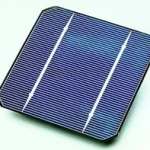Solar cell
A solar cell (also called a photovoltaic cell) is an electrical device that converts the energy of light directly into electricity by the photovoltaic effect. It is a form of photoelectric cell, can generate and support an electric current without being attached to any external voltage source. In order to generate useful power, it is necessary to connect a number of cells together to form a solar panel, also known as a photovoltaic module.

The development of solar cell technology begins with the 1839 research of French physicist Antoine-César Becquerel. Becquerel observed the photovoltaic effect while experimenting with a solid electrode in an electrolyte solution when he saw a voltage develope when light fell upon the electrode. The electricity increased when the light intensity increased.
Structure
Modern solar cells are based on semiconductor physics — they are basically just P-N junction photodiodes with a very large light-sensitive area. The photovoltaic effect, which causes the cell to convert light directly into electrical energy, occurs in the three energy-conversion layers.
Solar or photovoltaic cells are created from special materials such as Silicon (Si) mixed with other elements, which when exposed to sunlight will generate an electrical current. Basically sunlight is absorbed into the photovoltaic material, which in turn knocks electrons within the material loose. This allows the electrons to flow freely within the material structure, creating an electrical current.




